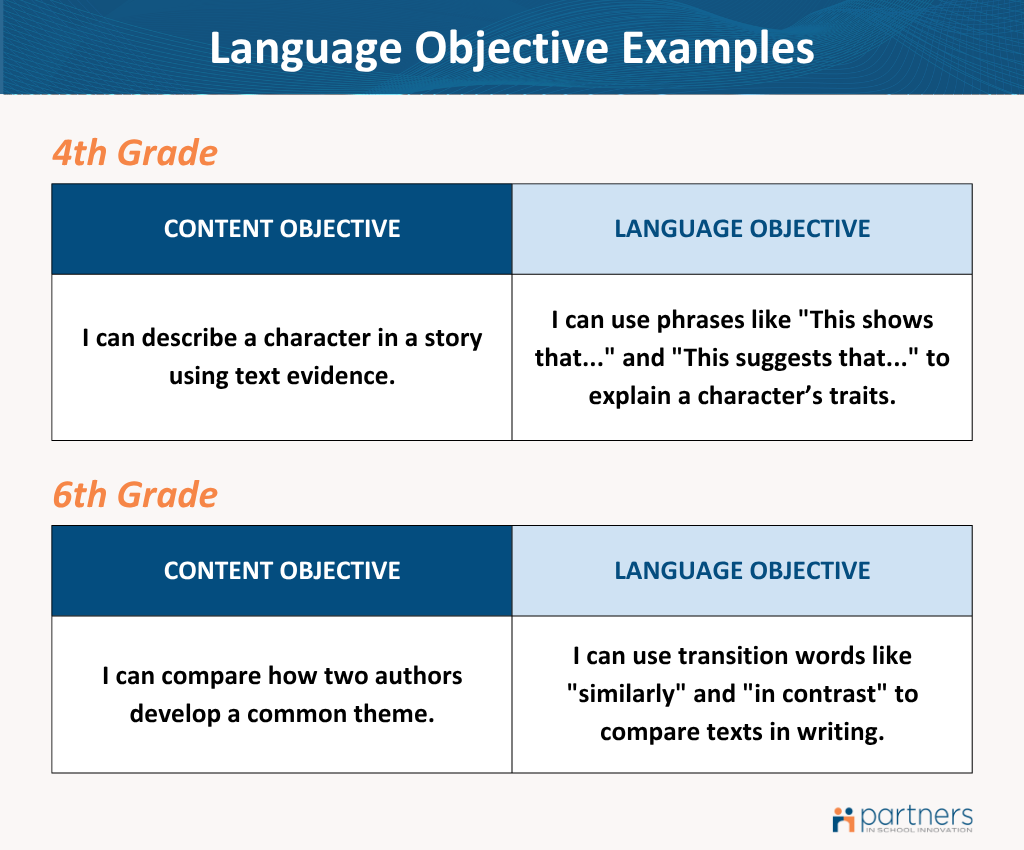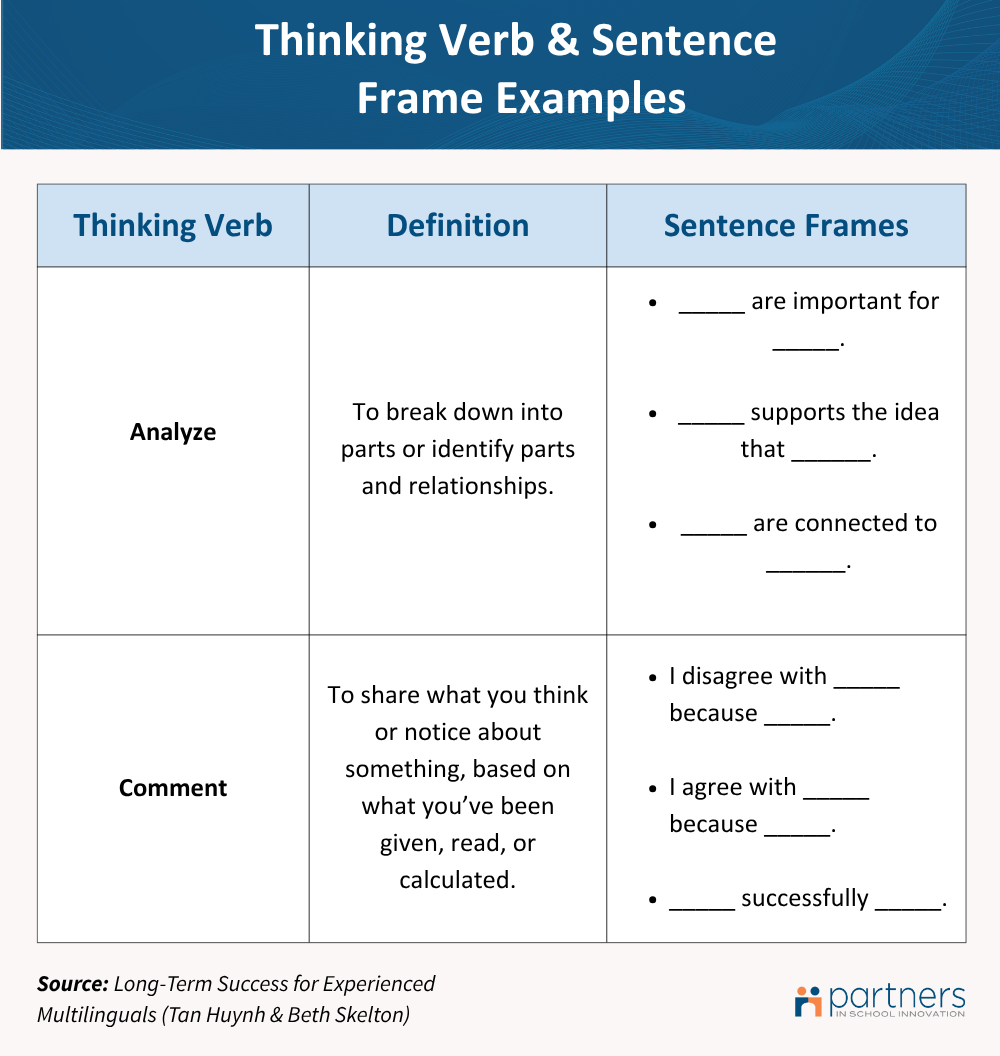Structured Language Practice: Strategies for Differentiating Instruction for MLLs
As educators, we want every student to engage in meaningful learning experiences. For multilingual learners (MLLs), that means going beyond content instruction to ensure they develop the academic language skills necessary to think critically, express their ideas, and fully participate in class.
As coaches working alongside educators, we’ve seen how structured language practice, or intentional opportunities for students to use and refine academic language, can help MLLs feel confident in sharing their thinking. When we create space for structured speaking, listening, reading, and writing practice, we set students up for success in discussions, complex texts, and communicating their learning effectively.
This article is part of a series on supporting MLLs with differentiated instruction. If you’re new to this series, here’s what we’ve covered so far:
Understanding and Supporting Multilingual Learners: A Guide to Differentiating Instruction
How to Create Language Objectives: Strategies for Differentiating Instruction for MLLs
(You're here!) Structured Language Practice: Strategies for Differentiating Instruction for MLLs
In this article, we’re covering how structured language practice builds fluency in academic language and how you can use strategies like Language Dives and structured discussions in your instruction.
Why Structured Language Practice Matters for MLLs
Research shows that explicit oral language practice leads to stronger reading comprehension, writing skills, and overall academic achievement (Echevarria, Short, & Vogt, 2008). Without it, students may struggle to put their knowledge into words, even when they fully understand the content.
One way to ensure MLLs have access to this kind of structured practice is through clear, intentional language objectives, a concept we explored in the previous article in this series. Language objectives give students a roadmap for using academic language by identifying specific vocabulary, sentence structures, or language functions they’ll need to engage with the content.
Image description: A graphic titled "Language Objective Examples" shows two grade-level examples. In 4th grade, the content objective is to describe a character using text evidence, and the language objective is to use phrases like “This shows that…” to explain traits. In 6th grade, the content objective is to compare how two authors develop a theme, and the language objective is to use transition words like “similarly” and “in contrast” in writing to make the comparison.
For example, in a history lesson on the causes of the American Revolution, the content objective might be for students to understand key events. To demonstrate their learning, they also need to use cause-and-effect language structures, such as:
"The Stamp Act led to increased protests because..."
"As a result of British taxation, the colonies..."
Without structured opportunities to practice these language patterns in discussions and writing, students, especially MLLs, may not have the tools to express their ideas clearly.
That’s where structured oral language practice comes in.
What Is Structured Language Practice?
Structured language practice is a deliberate and intentional approach to helping students use academic language accurately and confidently. It gives students multiple opportunities to:
Engage in structured academic discourse. This includes brainstorming, explaining, and justifying ideas.
Participate in teacher-guided and peer-to-peer discussions.
Share their learning through formal presentations.
Practice new vocabulary and grammatical structures in a focused way.
Unlike casual conversations, structured practice provides scaffolds and guided supports, providing students a clear pathway for success.
One effective way to engage students in structured language practice is through Language Dives.
What Are Language Dives and How Do They Build Academic Language?
A Language Dive is a structured conversation that guides students in unpacking and reconstructing complex sentences from a text, rubric, or learning target. This approach, widely used in EL Education’s curriculum, provides a scaffolded way for students to analyze how academic language works and apply it in their own speaking and writing.
The process is intentionally structured to help students build confidence with academic language. They:
Deconstruct the sentence by breaking it into meaningful chunks, discussing each part’s role and meaning.
Reconstruct the sentence by putting it back together, exploring variations, and understanding how small shifts impact meaning.
Practice using the structure in their own speech and writing to reinforce language patterns.
This structured approach supports multilingual learners (MLLs) and English learners with clear support to actively engage with academic language, rather than just memorizing vocabulary or passively hearing new words (EL Education Curriculum).
Language Dive Example: Unpacking Academic Sentences
Let’s look at how this could work in a science lesson with the sentence:
"Energy flows through an ecosystem as organisms consume food and transfer nutrients."
This is a dense academic sentence, and without support, many students, especially MLLs, may struggle to unpack its meaning or use it in their own explanations. A Language Dive offers structured, intentional support to guide them.
Here’s how a teacher might guide students through the Deconstruct-Reconstruct-Practice process:
Step 1: Deconstruct the Sentence
Break the sentence into chunks and ask questions to guide students in analyzing its structure and meaning:
"Energy flows through an ecosystem"
What does "flows" mean? Is it like a river flowing? Can we think of other things that "flow"?
Why "through an ecosystem" and not "in" an ecosystem?
"as organisms consume food"
Who are "organisms"? Can we name some?
"Consume" is a more academic way of saying "eat."
What happens when organisms eat?
"and transfer nutrients"
What does "transfer" mean?
What is being transferred? Why are nutrients important?
Can we think of other times something is "transferred" from one thing to another?
It might also be supportive here to have students act out, illustrate, or gesture the meaning of the sentence to reinforce their understanding.
Image description: Chart of “Questions We Can Ask During a Language Dive Anchor” split into questions about sentences, chunks, words, and language dives. [Source: EL Education’s curriculum]
Step 2: Reconstruct the Sentence
Once students understand the meaning of each chunk, you can work together to rebuild the sentence together, discussing how the parts fit and why they’re structured this way.
"As organisms consume food, energy flows through an ecosystem."
"When organisms eat, nutrients transfer between them."
"Nutrients move through an ecosystem as animals consume plants."
This phase is about flexibility and understanding how language works. This comes from guiding students to experiment with different word choices, seeing how small changes can shift meaning.
Importantly, guide them to notice patterns, like how "as" signals cause and effect, or how "transfer" is an action that connects the first and second half of the sentence.
Step 3: Practice the Structure
After taking apart the sentence and putting it back together, you’ll want to give students the opportunity to apply the structure on their own through speaking and writing. This step makes sure they actually internalize the language patterns and can use them independently.
Using the same grammatical structure, students create their own sentences like:
"Water cycles through an ecosystem as precipitation falls and evaporates."
"Heat moves through a house as sunlight enters and warms the air."
This structured, gradual release of responsibility helps students gain confidence in using academic language on their own and internalize it.
More examples
For real classroom examples of Language Dives in action, check out these EL Education videos:
While Language Dives are a powerful way to engage students in structured academic conversations, they are just one piece of the puzzle. To truly build MLLs' confidence and fluency in academic language, we need a variety of structured opportunities to practice English woven into daily instruction.
Here are some additional strategies that create meaningful language practice for multilingual learners.
Other Effective Strategies for Structured Language Practice
1. Turn and Talk with Purpose
Many classrooms use Turn and Talk, but for MLLs to get the most out of it, we need to be intentional about how we structure these conversations. Instead of broad, open-ended questions, use targeted prompts tied to language objectives.
For example, instead of asking, “What do you think about today’s reading?”, try:
"One key takeaway from the reading is..."
"I agree with ____ because..."
"One example from the text that supports my thinking is..."
Providing sentence frames helps students structure their thinking and practice key language patterns in a low-stakes, peer-supported setting (Calderón, Slavin, & Sánchez, 2011). Over time, students internalize these sentence structures and begin using them independently.
2. Think-Write-Pair-Share
Speaking on the spot can be intimidating for MLLs, especially when using new vocabulary or complex sentence structures. Think-Write-Pair-Share gives students time to process their thoughts before speaking, leading to richer discussions.
Here’s how it works:
Think: Students take a moment to reflect on a question.
Write: They jot down their ideas using a sentence frame or word bank for support.
Pair: They share their response with a partner.
Share: Pairs share key insights with the class.
This structured sequence reduces anxiety, increases participation, and allows MLLs to develop their ideas before speaking (Dutro, 2005). It also supports written language development, reinforcing the connection between oral and written expression.
3. Thinking Verbs and Sentence Frames for Structured Discussion
Academic discussions are more effective when students use precise language to express their ideas. Thinking verbs provide a framework for structuring responses, helping multilingual learners (MLLs) engage in discussions with clarity and confidence (Huynh & Skelton, 2022).
Teachers can incorporate thinking verbs into classroom discussions, writing assignments, and peer feedback by:
Modeling their use in explanations and responses.
Providing sentence frames to guide students in structuring their ideas.
Encouraging students to use them in discussions, debates, and written reflections.
Here are some examples of thinking verbs and how students can use them (Huynh & Skelton, 2022):
Image description: A table with three columns labeled Thinking Verb, Definition, and Sentence Frames. The first row shows the thinking verb “Analyze,” defined as “To break down into parts or identify parts and relationships,” with example sentence frames: “_____ are important for .” “ supports the idea that .” “ are connected to _____.”
By incorporating thinking verbs into daily instruction, teachers can help MLLs develop confidence in expressing, analyzing, and justifying their ideas, building their foundation for academic conversations and writing.
By integrating some of the strategies I covered, you can work to support MLLs with ongoing, scaffolded opportunities to practice and refine their language skills.
Of course, implementing these strategies effectively takes planning, reflection, and collaboration. If you're looking for more guidance or want to explore how these approaches can work in your school, we’re here to help.
Need More Support?
Our coaches at Partners in School Innovation offer hands-on support for schools and districts committed to creating equitable learning environments for all students, including MLLs and English language learners.
Contact our team to explore how we can support your goals and help you take meaningful steps toward equity.
Explore More Professional Learning Resources
Join Our Online Community of Educators
Collaborate with over 650 equity-focused education leaders sharing resources, ideas, and inspiration every week. This community connects you with peers navigating the same challenges and trusted leaders dedicated to solving systemic inequities.
Join the online community here.
Explore Online Professional Development Courses for Educators
Our on-demand, self-paced courses are designed by leading experts and focus on equity-driven strategies. These include curated activities, opportunities to practice, and space for reflection.
Popular courses include:
Leading Improvement Cycles
From Root Causes to Grassroots Action
Data for Liberation
Browse the full course catalog here.
Looking for something custom? We also create tailored courses for schools and districts. Let us know if you’d like to develop one designed to meet your unique needs.


![Chart of “Questions We Can Ask During a Language Dive Anchor” split into questions about sentences, chunks, words, and language dives. [Source: EL Education’s curriculum]](https://images.squarespace-cdn.com/content/v1/62d863c790e7f97e2cf0b914/f7b594ad-c94c-42e4-8528-6ef5fc5d3b54/250820_Blog4_MLLBlogSeries_SupportingMLLs_LanguageDiveQuestions.png)
